
 |
|
|
| EgyptAir Flight 990 Crashes Off The Coast Of Nantucket Island Coast Guard Crews Locate Debris From EgyptAir Flight 990 |
|
October 31, 1999, an EgyptAir 767 model 300 with 214 people on board crashed at sea, 60 miles of the cost of Nantucket Island, Massachusetts. The Boeing 767 was enroute from New York to Cairo, Egypt. The U.S. Coast Guard reports that it had found several bodies and several pieces of debris from a Cairo-bound EgyptAir Flight 990 passenger plane. The Coast Guard Cutter's Spencer and Reliance are on the scene along with HH-65 helicopters and HU-25 Falcon jets. Search crews have excellent weather conditions, winds are from the southwest at 10-15 knots, seas are 3-5 feet, visibility is 10 miles. |
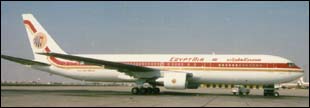 |
|
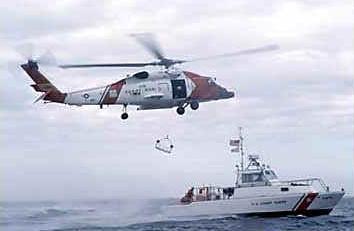 |
Flight 990 after being two hours and 20 minutes behind schedule departed New York's John F. Kennedy International Airport for Cairo at 1:05 am. Approximately 55 minutes into the flight air traffic controllers lost contact with the Boeing 767-300. EgyptAir owns three 767-200 ER's and two 767-300ER's. All the jets are equipped with Pratt and Witney high bypass turbofan PW 4060 engines. The crew consisted of 15. President Clinton was informed of the crash just hours before he was to travel to Norway for Middle East peace talks. Vice President Al Gore promised a thorough investigation to "learn whatever we can to avert further tragedies." Vice President, Al Gore, "The people of our country and people all over the world will have the families of those who are evidently lost at sea in our prayers and in our thoughts." The National Weather Service reported at the time the plane vanished from the radar screens, visibility in the area was roughly 10 miles and the wind was from the south at 9 mph to 10 mph. |
|
|
By mid afternoon, the media center for the Coast Guard search operation for the Egypt Air 990 search has been moved to Newport, R.I. Media are asked to go to Building 80 at the Naval Undersea Warfare Center in Newport. This facility will not be accessible by the media until 9 a.m. Monday, Nov 1. All further Coast Guard press conferences and briefings will occur at this location. The Coast Guard launched a massive and immediate search and rescue effort using every available resource. The search area is a 49 square nautical mile area with its center located 52-nautical miles south of Nantucket. A debris field was located approximately 60-miles south of Nantucket. The debris field consists of two partially inflated life rafts, seats, seat cushions, clothing, passports and other small pieces consistent with an aircraft crash. There have been no reports of survivors in the water. |
 |
|
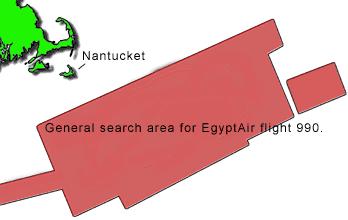 |
The Coast Guard has recovered one body. Coast Guard aircraft have flown 5,700 square miles in their search efforts. The search by the Coast Guard will continue the search throughout the night. On November 9, 1999, the flight data recorder from EgyptAir flight 990, which crashed into the Atlantic Ocean on October 31, arrived at the National Transportation Safety Board’s headquarters building in Washington, D.C. at approximately 2:30 this afternoon. It had been retrieved from the ocean’s bottom by the United States Navy at about 5:30 this morning, and flown to Andrews Air Force Base in suburban Maryland by Navy helicopter. The device is an Allied Signal Universal Flight Data Recorder, a tape-based unit that records the last 25 hours of aircraft operation. It recorded more than 150 parameters (items recorded, like airspeed, altitude, throttle setting, engine thrust, etc.). |
|
|
The flight recorder arrived at the NTSB’s laboratory in the presence of U.S. and Egyptian investigators. The magnetic tape was removed from its protective casing, cleaned and dried. The tape has data on it, and NTSB engineers are currently working to extract information. There will be no further statement on this today. November 10, 1999, the United States Navy, recovered the flight data recorder from EgyptAir flight 990 and had it flown down to the NTSB, Washington, DC. yesterday. NTSB engineers began working on the recorder in their laboratory upon recept of the flight recorder. After working late into the night, they took a break for a few hours, and have been back at work on the recorder since this morning. Under the procedures used by the NTSB, as well as Annex 13 of the International Civil Aviation Organization, the investigator-in-charge, Greg Phillips, is forming a flight data recorder group made up of specialists from the NTSB, the Federal Aviation Administration, Egyptian authorities, Boeing Aircraft Company and Pratt & Whitney Engines. |
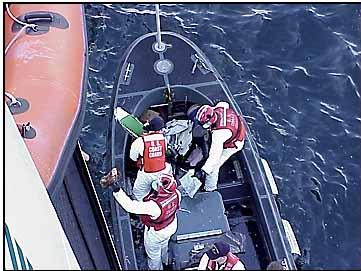 |
|
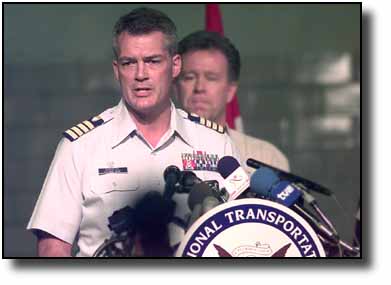 |
It will be their job to read out in more detail and confirm all the data pertinent to this accident. At this time the NTSB has some initial, preliminary data that have been shared, however the information is preliminary, and the information would not be elaborate on until the FDR group has had an opportunity to confirm the data. The data show an uneventful flight, cruising in level flight at 33,000 feet. The first event noted in the data is the autopilot disconnecting. About 8 seconds later, the airplane begins what appears to be a controlled descent. Data recovered so far indicates the airplane descending to about 19,000 feet; the NTSB is still in the process of recovering data from the remaining 5 to 10 seconds. The altitude profiles portrayed by the radar data and the flight data recorder appear to be consistent. The recorded data ends about the time of the last transponder beacon return. There is no evidence of thrust reverser deployment in the data. The aircraft does not appear to have reached supersonic speed during this descent. |
|
|
"As we are awaiting recovery of the CVR and are just beginning extensive work on the FDR with the flight recorder group, I cannot tell you at this time when we’ll have more recorder information to share with you". Unfortunately, heavy seas are anticipated Thursday, followed by a possible window of good weather on Friday and Saturday. NOAA ship Whiting is already back in port. The other smaller vessels involved in the recovery effort (Grapple, Mohawk, Oriole) will depart the salvage area this evening and arrive in port on Thursday to resupply and prepare to take maximum advantage of the predicted favorable weather conditions this weekend. SSV Carolyn Chouest will remain on site conducting ROV operations as long as weather conditions permit, supported by USS Austin and U.S. Coast Guard Cutter Juniper. |
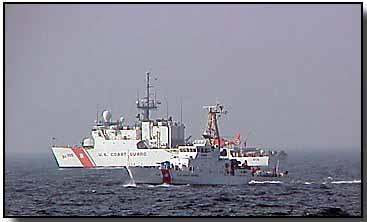 |
|
| ŠAvStop Online Magazine Contact Us Return To News |